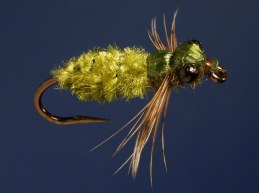Invicta Flies - Dragonfly Nymph
A quick, simple dragonfly nymph that is effective for bluegill and bass, other panfish, and lake trout. Vary the colors to match what is in your area. Colors can range from light tan to olive, to dark brown. These guys are often two-toned, so I generally lean more toward the underside color for the abdomen.

Hook: Eagle Claw 214, #8 (or any standard nymph hook)
Thread: Danville's Prewaxed 6/0, olive
Weight/Underbody: .020 & .015 lead wire
Abdomen: chenille, light olive
Wingcase: olive raffia
Thorax: olive rabbit with dark olive Antron
Legs: hen pheasant body feather fibers
Eyes: 2 mm plastic bead chain (or mono eyes)
Tying Instructions:
1) Attach thread to hook just behind eye and wind back to the bend to create a thread base. Bring thread forward to 1/4 the shank behind the hook eye. Lash the .020 lead wire to the far side of the hook, loose wraps, then pulling the thread toward you to tight. Reposition the lead as necessary. Continue rearward to the point on the shank that is between the hook point and the barb. Clip the lead wire, or carefully pull the thread tightly toward you to cut it. Repeat on the near side of the hook. Make three or four spiraling passes with the thread over the lead, and use your fingernails to make sure the lead on each side is aligned properly...we're going for a wide, flat profile.
2) Now take the .015 lead wire. Starting just behind the .020 lead on the sides, carefully (so as not to twist the sides out of place) wrap the .015 forward to the half shank mark, and pinch off with your fingernails or clip. Spiral the tying thread over the lead wraps to secure, about six passes, making the wraps a little tighter on each successive pass. Coat the wraps with super glue.
3) Bring the thread forward to about one and a half hook eye widths behind the eye. On top of the shank, tie in the plastic bead chain or mono eyes using figure-eight wraps. Use a permanent marker to color the eyes, if you like. For instance, here I've used olive-colored plastic bead chain, which I colored dark brown.
4) Wind the thread back to the bend. Strip the last 1/4 inch from the chenille, and tie this in by the exposed core. Bring the thread to the half-shank mark (just in front of the spiraled lead). Tightly wrap the chenille to the thread, tie off, and clip the excess. Now... trim the chenille on top and bottom only, very closely. Trim the butt on the sides to create a sharp taper. This gives us, with the wide underbody, the wide, flat profile of the natural's abdomen.
5) At the half-shank mark, tie in a section of raffia, the excess extending over the rear of the fly to be pulled forward later. Dub a tight thorax to about a hook eye width behind the bead chain eyes. I like to use rabbit mixed with a little Antron dubbing, but use anything that matches your local insects.
6) Just in front of the dubbed thorax, we'll tie in the legs. A variety of soft feathers can be used, including hen, partridge, pheasant, grouse, and others. Hen pheasant closely matches the locals I see, so that's what I've used. The fibers should reach just about to the butt of the fly. You can either locate a feather with fibers the proper length, or do as I have here and use a dubbing loop to use feathers with longer fibers. Just two turns of the hackle should do it. You can use the loop, or tie the feather in by its tip or butt, whichever is easiest for you. Take two turns, tie off, and clip the excess.
7) Stroke the fibers back so they lean rearward, then bring the raffia over the thorax, between the fibers, and tie down just in front of the hackle. Do not clip the raffia yet.
8) Apply more dubbing to the thread, then lift the raffia and tightly dub just in front to prop it up. Continue dubbing around the eyes, making figure-eight wraps, and taking a couple turns in front and back. Finish with the thread just behind the hook eye.
9) Bring the raffia forward between the eyes, and tie down. Clip the excess, leaving just enough exposed so as not to hinder the access to the hook eye. Dragonflies have a complex mouth system, so I like to leave this to add to the illusion. Whip finish the thread and clip.
10) Cement the thread wraps, and lightly coat the raffia as well. This adds a little durability to the fragile (when wet) material.
How to fish: Dragonfly nymphs like to hang out in weedy, grassy areas, often darting about to catch prey. Cast to weedbeds or let the fly sink, then strip the line in short erratic bursts about 3-4 inches long.